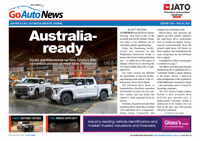Make / Model Search
News - Market Insight - Market Insight 2013Market Insight: Toyota celebrates 21 years at the topFamily favourite: Toyota's solid SUV lineup, that includes the popular Kluger, has proven to be a sales winner for the company in Australia. Australian market changes dramatically in two decades – except for Toyota domination11 Jan 2013 TOYOTA Australia has celebrated the 21st anniversary of its first win over arch rivals Holden and Ford in annual motor sales bragging rights in 1991 – a momentous turning point in local car manufacturer fortunes. Clocking up yet another win in 2012 – its 16th overall and 10th on the trot – Toyota reflected on how the market had changed in the intervening two decades and a bit. According to Toyota Australia executive director sales and marketing Matthew Callachor, new-vehicles sales have outstripped population growth by almost three times. In fact, vehicle sales have doubled, from 497,534 in recession-hit 1991 to a record 1.11 million last year. “The main reason is that cars are significantly more affordable now than they have been at any time since the mid-1970s,” he said. “This is due to rising wages, lower tariffs, improved technology and increased competition between manufacturers.  From top: Toyota Australia's Matthew Callachor Toyota RAV4 LandCruiser LandCruiser Prado. From top: Toyota Australia's Matthew Callachor Toyota RAV4 LandCruiser LandCruiser Prado.“Total full-time average weekly earnings have more than doubled since 1991 while interests are much lower. “While it took 40 weeks of average earnings to buy a six-cylinder family car in 1991, today it takes just 30 weeks.” According to Glass’s Guide, a Holden Commodore Executive, with its Buick-sourced V6 engine, had a list price of $29,760 in 1991, while the equivalent Commodore model today, the 3.0-litre Omega, is offered for $39,990 (although the special-edition Z Series can be had for $37,990) – a difference of about $10,000 or one third. Federal government data says the average Australian adult full-time wage was $610 a week or $31,720 a year in 1991, compared with $1352 a week or $70,304 a year in 2012. Based on those figures, a six-cylinder Commodore that required about 49 weeks of average wages in 1991 now costs the equivalent of 29 weeks of averages wages. Of course, cars have improved immeasurably in the intervening years as well. Mr Callachor comments: “Power windows and doors, smart phone connectivity, DVD players, satellite navigation, parking sensors, reversing cameras, stability control and a multitude of airbags are becoming increasingly common. “The strong Australian dollar and lower tariffs have made imports more competitive, which, in turn, has put downward pressure on local manufacturers to reduce costs and keep prices low.” Mr Callachor said that in 1991, fewer than 10 million cars plied Australian roads. “Today, there are 16 million,” he said. “Twenty-one years ago, Toyota took market leadership with 109,000 sales – fewer than half the total we sold in 2012.” While Toyota’s sale have doubled, its closest rival in 1991, Ford, has watched sales drop from 104,872 in 1991 to 90,408 in 2012. The company that was placed third in 1991, Holden, has made progress of sorts, with sales lifting from 83,292 in 1991 to 114,665 in 2012. But 1991 represented a historical low point for the lion brand, with Holden sales climbing out of that rut to a record 178,392 units in 2002 before starting a gradual slide over the past decade. Now, combined Holden and Ford sales struggle to match those of the Japanese giant. One of Toyota’s aces has been its strong SUV line-up that has allowed it to take advantage of the biggest sales phenomenon over the past two decades – the transition of rough and tough four-wheel drives into everyday family transport. Today, SUVs account for more than a quarter of all vehicles sales in Australia, topping 300,000 units for the first time in 2012. In 1991, passenger cars – the traditional family sedan, wagon and sports car – made up three quarters of all sales, but now the share has been eaten away to about 52 per cent. As Mr Callachor points out, hybrid vehicles did not exist in 1991, but Toyota sold more than 10,000 of these petrol-electric vehicles last year, while Lexus delivered a further 2300 – more than one third of the luxury car brand’s sales. All up, sales of hybrids in Australia in 2012 amounted to 13,919, with Honda being the other main contributor. Mr Callachor said that in 1991, large cars outsold medium cars by four to one, but last year, customers bought more medium cars – 87,674 versus 63,096. He said the number of brands had also proliferated with intense competition. “VW sold a grand total of 816 cars and Kia just 17 (in 1991),” he said. Last year, Volkswagen achieved 54,835 sales and Kia 30,758. “In 2002, the tenth best-selling brand in Australia sold just over 18,000 vehicles,” Mr Callachor said. “Today, due to the proliferation of brands and models, you need almost twice as many sales to sneak into the top 10.”  Read more |
Click to shareMarket Insight articlesResearch Market Insight Motor industry news |











Facebook Twitter Instagram